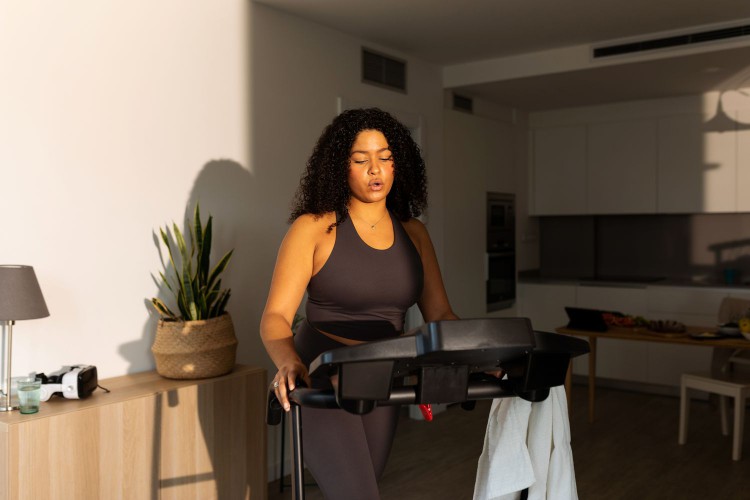'Cozy Cardio': Is the TikTok Trend a Good Workout?
- "Cozy cardio" is a new at-home fitness trend where people engage in low-impact exercise while staying relatively comfortable.
- The trend was started by TikToker Hope Zuckerbrow, who said that the relaxed workout experience makes physical activity more enjoyable and less intimidating.
- Cozy cardio may benefit the mind and body, experts said, but it's important that people also take time to challenge themselves to improve fitness and health.

Valentina Barreto/Stocksy
Many gym-goers subscribe to a "no pain, no gain" mentality when it comes to working out, but a new TikTok trend is flipping the mantra on its head—some users say that your daily cardio should be cozy instead of painful.
"Cozy cardio" typically involves some form of low-impact exercise done at home with a self-care twist. People complete their workout with comfortable clothes, dim lighting, their favorite movie or TV show, and even aromatherapy. The trend has since gone viral on TikTok.
Low-impact workouts such as walking or using a stationary bike aren't necessarily novel. However, the appeal of cozy cardio seems to be that it promotes exercise as something that feels enjoyable, rather than simply a chore to avoid.
There's a lot to love about this concept, specifically as a method of self-care, or as a way to add more physical activity to someone's day as they relax. But can cozy cardio really improve fitness levels, or is it simply another trivial exercise trend?
"The key lies in finding a balance between comfort and exertion to ensure that the workout contributes to improving cardiovascular health and overall fitness," Mike Hamlin, a certified strength and conditioning coach, told Health.
Here's what experts had to say about when cozy cardio can be effective, and the best ways to establish a comfortable, yet challenging workout routine.
Cozy Cardio Aims to Improve Mind and Body
The term "cozy cardio" was coined in late 2022 by TikToker Hope Zuckerbrow. She's since built a collection of nearly 30 videos on the subject, where she walks other TikTok users through her cozy cardio process. Zuckerbrow wakes up early, lights candles, makes her favorite protein coffee drink, puts on a movie, and then walks on a walking pad at a relatively relaxed pace. In some videos, Zuckerbrow even does her cozy cardio wearing a robe, fuzzy socks, and slippers.
Since she started posting, her cozy cardio content has gotten upwards of 2 million views, and has inspired others to post their videos trying the trend.
For Zuckerbrow, cozy cardio started as a way to heal her relationship with exercise.
“Society puts so much pressure on women to look a certain way, and because of that, a lot of them have turned exercise into a punishment,” she said a recent video. Creating a relaxing ritual around her workout has helped Zuckerbrow enjoy being active—for her, cozy cardio has become a form of “meditational self-love.”
Cozy cardio might also be a useful tool to help people get back into the habit of doing physical activity. And the fact that it's done in a comfortable environment—specifically, at home—may be a way to overcome some apprehension or fear around working out in front of other people.
Zuckerbrow admits she suffered from a serious case of “gymxiety” that held her back from going to a gym or otherwise exercising in public. About half of Americans feel the same way, according to a 2019 survey.
"The cozy cardio trend seems to have a positive intention of making exercise more enjoyable and less intimidating,” said Hamlin. “I love this, because incorporating elements of comfort and entertainment can potentially make the experience more appealing and get more people involved.”
In addition to making physical activity feel a bit less intimidating, cozy cardio may also help people exercise more frequently. Since the workout is done at home, there's no need to put on exercise clothes and physically go to the gym. This easy-access and comfortable experience could be the perfect no-pressure entry to fitness.
“I could see cozy cardio being very effective at slowly building up positive associations with fitness, which is super beneficial for long-term health,” said Hamlin.
10 Realistic Fitness Goals, Recommended by Personal Trainers
Is Cozy Cardio Enough of a Workout?
It’s important that cozy cardio is also assessed by its ability to deliver real fitness benefits, Hamlin said. For anyone other than a beginner, cozy cardio will likely lose effectiveness as fitness levels plateau.
“I don't mind the idea of finding new forms of exercise that are enjoyable, as they can lead to better workout retention over the long term,” said Hamlin. “We just need to make sure that we don't get caught thinking that a super light exercise session daily will always be enough."
The Centers for Disease Control and Prevention (CDC) recommends that adults get a minimum of 150 minutes of moderate-intensity cardio each week. For an activity to qualify as moderate-intensity, it has to be challenging enough to raise a person's heart rate and make them get a bit sweaty. If someone's doing a moderate-intensity activity, they should be able to hold a conversation, but not sing, the CDC adds.
This is just the baseline, however. A 2022 study found that adults who exercised at least 150 minutes per week had a substantially lower risk of death from all causes than those who didn’t. But the risks were even lower for those who exercised longer and at a higher intensity.
Doing a moderate-intensity cozy cardio workout for at least 150 minutes per week can certainly support a healthy lifestyle. But to grow strength and increase health benefits, people need to challenge themselves.
“If you want to have a really effective workout, you've got to move your muscles and put strain on them,” Josh York, certified personal trainer and owner of GymGuyz, told Health. Over time, your body adapts to the strain by growing stronger and fitter.
“A lot of times, getting to a point where you are really working your muscles requires you to be uncomfortable,” he added.
How To Use Walking for Weight Loss
A Healthy Compromise
If someone's goal is to add more movement to their day, relieve stress, or overcome anxiety around fitness, then cozy cardio may be a great addition to their weekly routine. To see more significant improvements in strength or fitness, however, a little discomfort may be necessary.
This is something that Zuckerbrow herself seems to understand—in addition to cozy cardio, she also posts videos of more intense gym sessions. Balance is key.
In order to create that more balanced workout routine, it's best to start with small changes. For example, people can consider increasing the incline when they walk on the treadmill, York said. These increases in intensity can help improve fitness over time.
“You can still have that element of comfort, but by incorporating an incline, you can bring up your heart rate and add in a little extra burn," he said. If you’re walking outside, find some hills instead of sticking to flat terrain.
Plus, trying out a new or more intense form of exercise doesn't always have to feel challenging or negative. If it's the cozy cardio mindset that people are after, they can seek out other forms of exercise that may not even feel like a workout, such as dancing, raking leaves, or hiking with a friend.
But as long as a person is challenging themselves, they'll continue to see improvements in health and fitness—it really doesn't matter whether that's weightlifting at the gym or walking in bunny slippers at home.
Out of Breath Walking Up Stairs? Here's Why—and 3 Things To Do About It








